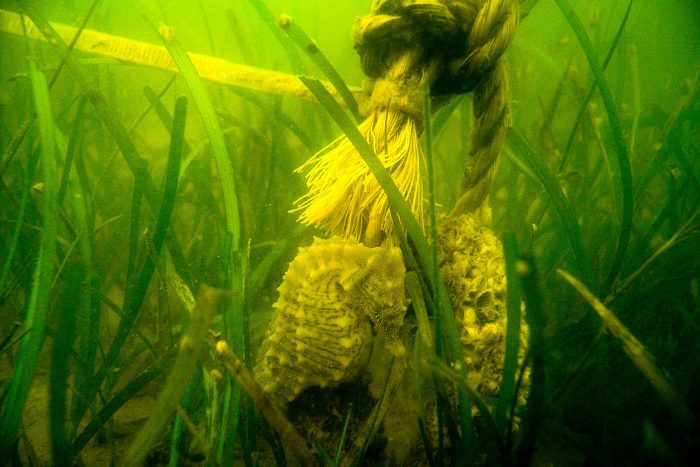Eelgrass
Zostera marina
Eelgrass is an underwater grass with long, ribbon-like leaves. It grows in the saltier waters of the middle and lower Chesapeake Bay.
This section shows one large critter image at a time. Use the thumbnails that follow to select a specific image to display here.

This gallery contains a grid of small thumbnails. Selecting a thumbnail will change the main image in the preceding section.
Appearance
Eelgrass is made up of long, ribbon-like leaves. Leaves can grow to be 4 feet long, but vary in size depending on the plant’s location. A wide, tube-shaped sheath is at the base of each leaf. Eelgrass has thick, creeping rhizomes with many roots and nodes.
Predators
Cownose rays root through bottom sediments for their prey and destroy eelgrass beds in many areas.
Reproduction and life cycle
Asexual reproduction takes place when the rhizome grows and winter buds called turions form. Sexual reproduction takes place in early summer, when female flowers are fertilized by drifting pollen and develop into seed-bearing shoots. The shoots eventually break off, float to the surface and release their seeds.
Did you know?
- Part of its scientific name, Zostera, means “belt” in Greek. This refers to the plant's ribbon-like appearance.
- Migratory waterfowl such as brants, redheads, widgeons, black ducks and Canada geese feed on eelgrass, as do green turtles.
- Eelgrass provides important foraging areas and habitat for blue crabs. Juveniles and molting adults hide from predators among eelgrass beds.
- It can be confused with wild celery. You can distinguish eelgrass by its leaves, which are narrower than wild celery’s. Additionally, eelgrass only grows in the saltier waters of the middle to lower Bay, while wild celery grows mostly in fresh water.
Sources and additional information
- Underwater Grasses in Chesapeake Bay & Mid-Atlantic Coastal Waters by Maryland Sea Grant
- Life in the Chesapeake Bay by Alice Jane Lippson and Robert L. Lippson
- Chesapeake Bay: Nature of the Estuary, A Field Guide by Christopher P. White
- SAV Key: Eelgrass – Maryland Department of Natural Resources
- PLANTS Profile: Zostera marina – USDA Natural Resources Conservation Service
